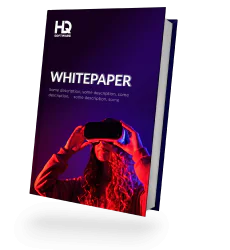What Is Augmented Reality (AR)?
The Differences Between Mixed Reality and Augmented Reality
Future Trends in Augmented and Mixed Reality
Partner With HQSoftware for Top-Notch AR, VR, and MR Solutions
Is the future of computing a seamless blend of the digital and physical worlds? Answering that question requires understanding the subtle yet significant differences between Mixed Reality (MR) vs Augmented Reality (AR). While both offer immersive experiences across various sectors, from gaming to healthcare and manufacturing, their approaches to interaction and the hardware they utilize set them apart.
As the founder of a company specializing in AR/VR development services, I am keen to offer my insights about Mixed Reality vs Augmented Reality. With extensive experience in the field, I’ve witnessed firsthand the evolution of these platforms and their capacity to redefine how we interact with our environment.
In this article I’ll discuss the unique characteristics that distinguish Mixed Reality from Augmented Reality and consider the potential they hold for changing our digital experience.
What Is Augmented Reality (AR)?
The Differences Between Mixed Reality and Augmented Reality
Future Trends in Augmented and Mixed Reality
Partner With HQSoftware for Top-Notch AR, VR, and MR Solutions
Augmented Reality takes the real world as its canvas and adds digital elements on top. Imagine holding your smartphone up to a street scene and seeing a virtual tour guide pop up, offering information about the local landmarks. Or, maybe you’re playing a mobile game where digital creatures appear to be running around your living room. This is how AR overlays digital information onto the real world, enriching our perception of reality.
Such AR applications can be accessed through various devices, such as smartphones, tablets, or specialized AR glasses. These devices use computer vision, cameras, and displays to superimpose virtual elements, such as 3D models, text, images, or video, onto the user’s view of the real environment in real time.
For example, we at HQSoftware have developed an AR app that aids in maintaining a healthy diet by comparing the user’s meal portions to the size of their fist. Harnessing the power of Augmented Reality, the developed system uses a camera to recognize meals and superimposes a customized fist image over them. Users can track their daily progress by selecting portion sizes ranging from 0.5 to 3 fists. The solution also accounts for the category of food being analyzed—be it appetizer, main course, dessert, and so on.
Mixed Reality, in turn, encompasses a spectrum of experiences that includes both Augmented Reality and Virtual Reality, offering a more immersive experience than AR alone. While VR immerses users entirely within a digital environment, MR blends digital elements into the real world, allowing for interaction with both.
MR requires more advanced processing and sensor technology than AR, including depth sensors, spatial awareness capabilities, and more sophisticated software algorithms. So devices that support MR, such as certain smart glasses or head-mounted displays, are equipped with these technologies to provide a convincing experience.
In Mixed Reality, digital objects are not just overlaid on the real world as they are in AR, but are integrated into it in such a way that they can interact with the physical world. This interaction can include the ability to manipulate virtual objects with real-world actions or have virtual and physical objects influence each other’s behavior. For instance, a virtual ball under MR conditions could roll off a real table and bounce on the actual floor, obeying the laws of physics as if it were a real object.
Below you can explore a visionary demonstration from Microsoft showcasing the potential of working within a Mixed Reality environment:
Having delineated what Augmented and Mixed Reality are and how they uniquely blend the physical and digital worlds, let’s look back at the journey that has led us to this technological frontier.
To help you understand Augmented Reality vs Virtual Reality vs Mixed Reality more precisely, I’ve created a table that sheds light on the historical development of these technologies. I’ve showcased their distinctive paths and impact on various industries.
| Year | Augmented Reality vs Mixed Reality |
|---|---|
| 1968 | The concept of AR was launched with Ivan Sutherland’s “The Sword of Damocles,” the first head-mounted display system. |
| 1990 | The term “Augmented Reality” is introduced by Tom Caudell and David Mizell.
The first fully immersive AR system, Virtual Fixtures, is developed in the U.S. Air Force’s Armstrong Laboratory. |
| 1994 | The term “Mixed Reality” is defined by Paul Milgram and Fumio Kishino as part of the Reality-Virtuality Continuum in their paper “A Taxonomy of Mixed Reality Visual Displays.” This continuum illustrates the spectrum between completely real environments and completely virtual environments. |
| 1992-1999 | The 1990s saw significant progress with systems like Louis Rosenberg’s Virtual Fixtures in 1992, which enhanced user performance in teleoperation tasks.
In 1998, AR entered sports broadcasting with the introduction of the “First Down” line, also known as the “Yellow Line.” This virtual line, superimposed onto the football field during televised NFL games, enhanced the viewer experience by making the game easier to follow. |
| 2000s | AR becomes more mainstream with the proliferation of smartphones.
AR development tools for mobile applications are introduced. |
| 2009 | Apps like Layar and Wikitude are launched, utilizing smartphone sensors to overlay digital information onto the physical world. |
| 2010s | Apple launches ARKit and Google introduces ARCore, enabling widespread development of AR apps. |
| 2012 | Google introduces Google Glass, an early attempt at consumer AR smart glasses offering hands-free access to information. |
| 2015 | Microsoft launches HoloLens, a significant step forward for MR, allowing users to interact with holographic content. |
| Today | AR is widely used in various applications, from gaming to navigation and retail.
MR technology continues to evolve, offering more immersive experiences and blurring the lines with AR. |
This table outlines the key historical milestones for both Augmented Reality and Mixed Reality, highlighting their separate development and the eventual convergence of the two technologies.
At first glance, Mixed Reality and Augmented Reality may seem interchangeable, as both integrate digital and physical components. However, closer inspection reveals notable differences between the two. The table below summarizes these key differences:
| Criteria | Mixed Reality | Augmented Reality |
|---|---|---|
| Interactivity and user experience |
|
|
| Industry applications |
|
|
| Devices | Specialized MR headsets like Microsoft HoloLens, MR smart glasses | Smartphones and tablets with AR capabilities AR smart glasses like Google Glass, AR headsets |
| Major companies | Microsoft (HoloLens), Magic Leap (Magic Leap One) | Apple (ARKit for iOS devices), Google (ARCore for Android devices), Snapchat (Snapchat Lenses) |
Now, let’s examine each criterion in more detail.
As I see it, the core technological differences lie in the level of interaction and immersion. AR primarily provides a one-way experience. Users can see digital information overlaid on their real-world view, but they can’t typically manipulate or interact with the digital objects in a meaningful way. The experience is largely limited by the device’s capabilities and screen size.
MR, however, offers a much higher degree of two-way interaction. Users can manipulate and interact with digital objects within the real-world environment, creating a more immersive and engaging experience. This enhanced interaction is enabled by sophisticated tracking and sensing technologies that allow the MR system to understand the user’s position and actions within the physical space. This increased level of immersion and interaction is what makes MR particularly well-suited for applications requiring precise manipulation and realistic simulations.
Need a custom software solution? We’re ready to help!HQSoftware has a team of skilled professionals ready to tackle the project. Ask me!
Natallia Rudzik
Business Development Manager
On a more practical level, AR has found widespread adoption across various sectors because of its availability, the retail industry in particular uses AR for virtual try-ons, allowing customers to see how clothes or makeup would look on them without physically trying them on. Navigation apps also leverage AR to provide real-time directions overlaid on the user’s camera view. Advertising utilizes AR to create interactive campaigns, enhancing engagement and brand recall.
Mixed Reality, due to its higher technological requirements and cost, finds its strength in more specialized applications. Healthcare utilizes MR for surgical planning and training, allowing surgeons to practice complex procedures in a simulated environment before operating on a patient. Manufacturing uses MR for design and prototyping, enabling engineers to visualize and interact with 3D models of products before they’re built. Similarly, the architecture and engineering fields leverage MR for design visualization and collaboration.
While developing AR/VR solutions, we at HQSoftware employ various types of devices. Based on our software development expertise, Augmented Reality is particularly accessible thanks to its reliance on widely available devices.
Smartphones and tablets form the backbone of most AR applications, with the camera and screen serving as the interface. While dedicated AR glasses exist, for example Snap Spectacles, they haven’t achieved widespread adoption yet. Major players in the AR space include Apple with ARKit, Google with ARCore, Snap, and Microsoft with HoloLens, which also has MR capabilities.
Mixed Reality typically requires specialized headsets. Microsoft’s HoloLens 2 is a prominent example, offering a high degree of interaction and immersion. Magic Leap also produces MR headsets, though their market penetration is less than Microsoft’s.
In short, AR enhances the real world with digital overlays, offering a relatively simple user experience often accessible via existing devices. MR creates a more immersive and interactive experience by blending digital and physical environments, usually requiring specialized headsets. While AR applications are widespread, MR is currently finding its niche in industries demanding high levels of interaction and precision.
How do modern businesses use AR to increase their revenues and outperform their industry competitors?

As we peer into the future, both Mixed Reality and Augmented Reality are poised to impact various industries, driven by advancements in technology and increasing adoption rates. In my opinion, embracing these trends will be essential for business owners aiming to stay competitive in the market:
In conclusion I can say that, while AR offers a gateway to enhanced experiences by overlaying digital information onto our surroundings, MR takes this a step further by enabling dynamic interactions between the two worlds.
As your outsourcing development provider, at HQSoftware we can provide:
Get in touch with us to discover how we can assist you in creating top-notch AR, VR, and MR solutions.

HQSoftware Founder
Having founded the company in 2001, uses his broad knowledge to drive the company forward. Ready to share his wisdom on software development and technology insights
We are open to seeing your business needs and determining the best solution. Complete this form, and receive a free personalized proposal from your dedicated manager.

Sergei Vardomatski
Founder